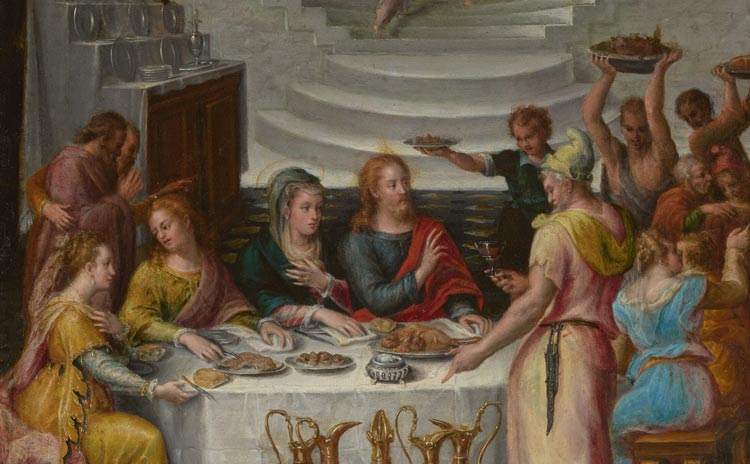The Getty Museum in Los Angeles has purchased a work by Lavinia Fontana (Bologna, 1552 - 1614), the Wedding at Cana, a small oil painting on copper measuring 47 by 36 centimeters. The museum purchased it from U.S. antiquarian Nicholas Hall. The work, originally intended for private devotion, depicts the famous episode from the Gospel of John (2:1-11) in which Jesus, invited to a wedding together with his mother and disciples, turns water into wine after the Virgin noticed that the wine had run out.
In Lavinia Fontana’s work, Christ and Mary are seated at the center of the table, with the groom on their right and the bride seated at the head of the table. The other guests are gathered around the table, while behind them come some servants with plates of food. Lavinia Fontana shows the moment of the miracle, when Jesus raises his hand in blessing: the gold pitchers in the foreground are evidence of the miracle. On the left wall is a sideboard with a rich display of silver plates, while an elegant peristyle in the form of an exedra appears at the top of the composition, accessed by a double semicircular staircase, part concave and part convex. The artist meticulously applied paint in thin layers and added rich glazes, resulting in a glossy, luminous and highly detailed composition.

Before arriving at the Getty, the work, which was reported in Britain in 1924 (according to Hall, however, it may have been a work that was formerly part of the collection of Ferdinand I de’ Medici, grand duke of Tuscany), toured several private collections, and in 2010 it was even sold at auction at Sotheby’s in New York (the estimate at the time was $150-200.000), only to be purchased by Nicholas Hall who sold it to the Getty. The purchase is part of the policies, typical of American museums, of replenishing their collections with works created by women: in fact, already last year, the California museum had purchased Artemisia Gentileschi’s Lucrezia , making explicit the motivations that led it to grab the work. Moreover, Fontana’s work joins other paintings from the Bolognese school at the Getty: there are already paintings by Ludovico Carracci, Guido Reni, Domenichino, Guercino, and Guido Cagnacci.
The work was attributed to Lavinia Fontana by scholars Aoife Brady and Babette Bohn, who independently confirmed the attribution of the Wedding at Cana to Lavinia Fontana based on a high-resolution digital image. Brady dates this copper to the late 1570s to early 1680s, and suggests that the palette, architectural setting and marble floor tiles of the present copper are closely related to the Christ in the House of Mary and Martha of about 1580, the artist’s first documented public commission, painted for the chapel of the Conservatorio delle Putte di Santa Marta in Bologna. Bohn considers the work under review “very beautiful and in excellent condition” and notes that “it has some similarities in treatment with the ’Annunciation [c. 1576] in the Walters Art Gallery, Baltimore...but it is obviously much more complex and ambitious.” Although the composition is reminiscent of the works of Prospero Fontana (Lavinia’s father) and other Mannerist Bolognese painters of his generation, suggesting an earlier date, Bohn considers this painting too sophisticated to be placed before 1576 or 1577. Fontana painted the Wedding Feast at Cana on another occasion, in a work dated 1577: this is a larger painting on canvas, last recorded in a private collection in Venice.
 |
| Getty Museum in Los Angeles acquires important work by Lavinia Fontana |
Warning: the translation into English of the original Italian article was created using automatic tools. We undertake to review all articles, but we do not guarantee the total absence of inaccuracies in the translation due to the program. You can find the original by clicking on the ITA button. If you find any mistake,please contact us.